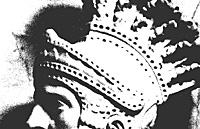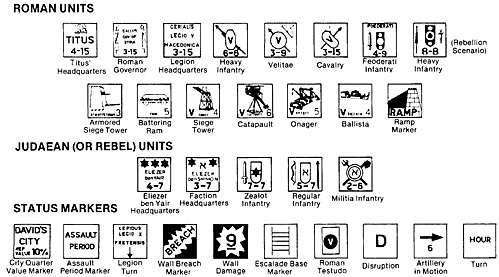 When John Kula asked me to write a
piece for an upcoming edition of his
magazine, it brought back a number of
memories concerning Siege of Jerusalem
going back to its original development as
an amateur publication over a quarter
century ago.
When John Kula asked me to write a
piece for an upcoming edition of his
magazine, it brought back a number of
memories concerning Siege of Jerusalem
going back to its original development as
an amateur publication over a quarter
century ago.
Back in 1974, my gaming buddies and I would meet once a week in the Bronx to war game. To this day, I still weekly game with most of them, although we’ve relocated to Rockland County (a suburb north of New York City). Sadly, one of our number, the fellow in whose Bronx apartment the first Siege of Jerusalem prototype was unveiled, is no longer with us …Rob was at his Aon Insurance office on a floor of the World Trade Center above where those bastards’ hijacked jet hit on 9/11/01. We’ll miss him.
To those of us who’ve read The Avalon Hill General Volume 26 Number 4, some of this may be repetitive, but a bit of “flashback” as to how Siege of Jerusalem developed seems in order.
This was indeed an amateur game inspired by my friend and Siege of Jerusalem partner Steve Weiss. Steve had lived in Israel and was always fascinated by ancient history, and walking the original ground of the siege inspired him. Steve is very artistic, and took his recollections of the ground, plus the Hebrew University’s excellent archeological research regarding first century Herodian Jerusalem, and converted it into a hand –drawn game map.
For those who are interested, The Hebrew University’s research is reflected in an incredibly impressive outdoor scale model of ancient Jerusalem which can be viewed in Israel at the Holyland Hotel.
This model was photographed for the TV mini-series Masada ( a video cassette one can rent ) and used as basis for some wonderful computer-generated images within a more recent Jesus and the Rose of Christianity television show which aired on the Discovery Channel.
After the game’s initial publication, a gamer wrote us that he converted a rendition of this model to do Siege of Jerusalem as a miniatures game (the mind boggles!). We’ve yet to verify this and would certainly have treasured any photographs of such a project showing a game in progress.
There’s more or less constant “digging” going on in and around Jerusalem. Biblical Archeology is a fine periodical to keep up to date with any latest development. In fact while John and I were exchanging emails regarding my doing this article, he questioned whether a newly discovered “gate” was reflected in the game map. Over the years, a number of similar revelations have occurred … although nothing major (to my knowledge).
These small gates, in the military simulation Siege of Jerusalem depicts, in my opinion would have been sealed to such an extent that they’d be indistinguishable in game terms to the walls themselves. Were we doing a new edition of the game map, a serious assessment of recent archeological research would b considered.
As to Siege of Jerusalem’s combatant armies, an article by Jim Werbaneth, appearing in last winter’s Line of Departure Wargaming Quarterly, got it right. The units are standardized and stylized for effect. This garnered some criticism, as the research is there for a far more detailed Roman Order of Battle, but the design approach used keeps players focused more on what each piece can do, in what is, in my opinion, an acceptable level of detail.
Too much variety in combat strengths would slow the pace of the game as players would need more time to compose their stacks for the best possible effects. Incidentally, Jim, with his local gaming friends, performed yeoman service as a blind test team during development of Siege of Jerusalem’s Avalon Hill edition for which I’m ever grateful.
I’ll not get into the history behind Siege of Jerusalem here, other than referring folks back to The General Vol. 26, No. 4 that covered the topic and included an article converting the course of the historical siege into game terms.
Personally, I prefer works of historical fiction concerning the period over pure history as they make the period “alive” and of far more interest (at least to someone such as myself). It was reading books such as The Source which sparked my interest in doing the traditional research.
Back in those seventies “Bronx Gaming Days”, I was affiliated with SPI (worked there full time as their “Skonkwerks” office manager, 1969-1972, and stayed in touch until the company’s demise under the Chris Wagner Regime). So, courtesy of Jim Dunnigan and the crew, I knew something of the game publishing business and used my supplier contacts, when enough folks kept telling Steve and me that the war game we devised for our personal amusement could have commercial possibilities, into printing 1,000 Siege of Jerusalem, 70 A.D. games as a pro-amateur publication under a partnership known as Historical Perspectives.
These first games were hand-collated by us, with help from my younger brother and his friends in true “cottage industry” fashion within my small Queens, N.Y. apartment. To this day, I owe my beloved wife for tolerating the running of a gaming business out of our home.
So in 1976, Steve and I set forth for the Origins II Convention in Baltimore via his trusty International Scout ... what passed for an SUV in those days. Steve was ahead of the curve there, and to our surprise sold every copy of Siege of Jerusalem we brought.
Furthermore, my demonstrations of the game attracted large and enthusiastic audiences. My voice grew raw from hours of pitching and explaining the game (but it was terrific fun and most gratifying to find our labor of love so well received!). The industry reviews were also kind and the game developed a nice following.
We particularly got a kick with folks from outside the USA displaying interest in the game. When my son visited Paris a couple of years ago, he ventured into a local hobby shop and, lo, there was a group of French gamers playing Siege of Jerusalem! Various schools, including religious institutions, which at least used the game map to show what Jerusalem looked like during New Testament times, purchased copies of the game.
In 1978, Historical Perspectives published and quickly sold out a Second Edition and during the 1980’s, discussion of publishing Siege of Jerusalem as an Avalon Hill game began with Don Greenwood (who’s been a friend going back to his Panzerfaust magazine days, when we both were unmarried and had a lot more hair. We’re still “kicking around” games: most recently with Mark McLaughlin’s superb The Napoleonic Wars from GMT with which I’m proud to be a recent addition to “The Team”).
It took a while, but eventually, thanks to Don’s good efforts, laudable patience and sponsorship, The Siege of Jerusalem was published by Avalon Hill with some substantial changes to its game mechanics. It achieved new critical recognition by winning the 1990 “Charlie” (Charles Roberts) Award for its category.
Why do the original amateur versions of Siege of Jerusalem differ from the Avalon Hill edition still in distribution via Multiman Press? That could be an article in and of itself. Suffice it to say that Steve and I are pleased with the results enabled by Don’s (and others of the AH Team’s) excellent contributions to the final product. The game continues being refined as evidenced by the new material accompanying this article. Siege of Jerusalem players may notice little in the way of truly innovative game mechanisms in the design. This was deliberate. I tried to use established gaming concepts to ease “the learning curve”.
For example, the alternating fire and move phases approach first came to my attention while with SPI through a Test Series Game entitled Deployment, which simulated tactical/operational combat during the Napoleonic Period. (Give yourself beaucoup “grognard points” if you recall that particular game from “ the good ole days” of our hobby.)
The concept of Assault Periods comes right from Caesar/Alesia, which I first encountered as an amateur publication over thirty years ago ... when its oversized map came rolled up in a tube (more grognard points to any who recalls it).
Those who play miniatures would not find Siege of Jerusalem’s principle of reducing a fortification’s initial strength to the point of it being “breached”, unfamiliar.
Perhaps it’s how Siege of Jerusalem puts these “tried and true” wargame mechanisms together into a single package which makes the game somewhat unique, particularly the intermingling of miniature and board gaming design concepts. I’ve certainly been grateful for using the design approach we did, for with experienced gamers, from the Origins II Convention through the present day, I’ve been able to teach the game with about a half hour of instruction. Folks swiftly get into actually spending time scrutinizing its rules.
Having advance knowledge of what the concept of a ZOC is, movement allowance, stacking, melee versus firepower combat, morale, etc., all help accelerate the learning process. Players seem to enjoy the scope and grandeur of The Full Siege Game.
To this day, seeing the playing pieces of Legio V “Macedonica”, Legio X “Fretensis”, Legio XII “Fulminata” and Legio XV “Appolinaris” arrayed upon the beautifully painted Siege of Jerusalem map as they converge upon Jerusalem’s impressive walls, defended by that apparently “thin blue line” of Judean freedom fighters, still stirs my old grognard heart ... you can almost hear the Legionnaires’ swords rhythmically beating the rebels doom as they thrum upon their shields.
Alas, the Full Siege Game takes a L-O-N-G time to complete, so I subsequently designed a First Assault Period Scenario, That is a key point. Siege of Jerusalem, as long as it’s played by folks with interest in the game and historical period, should keep evolving.
As you know, I’m one of the original SPI crew going back to the days when S&T came out of a basement office underneath a bodega in New York’s East Village.
One of SPI’s founders was author and teacher Al Nofi. Al was visiting City College in Manhattan when he spotted a group of students enthusiastically playing a game of Siege of Jerusalem in the study hall.
You can imagine the scene: the constant buzzing undercurrent of conversational chatter in the crowded hall. Then, one of the Roman team got so carried away with the game action that he blurted out loudly “Kill the Jews!” to cheer on his teammate who was about to roll for a particularly critical attack. The abrupt shocked silence in the study hall was deafening. For years after, every time I saw Al at a convention, he’d recount the tale with a chuckle.

The Siege of Jerusalem: 70 AD Scenarios
The Siege of Jerusalem Review and Analysis
The Siege of Jerusalem: Designer's Notes
Jerusalem and Matthew 19:24 : Camel Through Eye of Needle
Back to Simulacrum Vol. 4 No. 4 Table of Contents
Back to Simulacrum List of Issues
Back to MagWeb Master Magazine List
© Copyright 2002 by Steambubble Graphics
This article appears in MagWeb (Magazine Web) on the Internet World Wide Web. Other articles from military history and related magazines are available at http://www.magweb.com